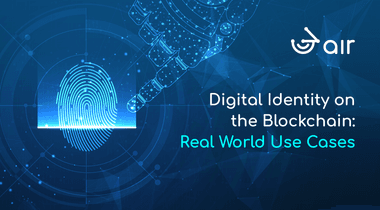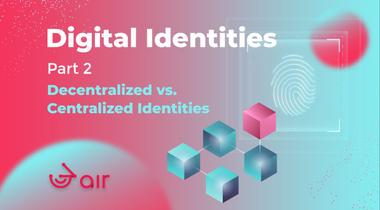Digital Identity on the Blockchain: Real World Use Cases
When people think about the concept of a digital identity they often think about authentication processes that come with proving your identity online. While much of the internet thrives on anonymity—like social media platforms, message boards and other content platforms—other parts of the internet need to be able to authenticate your identity in order to grant you access to certain things.
One of the biggest problems with the internet thus far is that there is no standardized and universally secure way of proving your identity or personal data online. Some websites and services have set up mechanisms to allow users to prove their identities for certain features—like showing your state ID to secure verification on a social network or entering your social security number to pay taxes online. Any and all of this data is called a Digital Identity, or DID, and includes anything from your nickname to your social security number. If it can be used to identify you, it’s part of your digital identity.
Identifying the Need for DIDs
While these DID entry and storage methods have certainly worked to a certain degree, users are generally unable to control what happens to their data once they submit it. Billions of dollars have been spent on securing sensitive data, and even when data is obtained legally it can still be misused. As a user, every time you enter your data on an online forum—whether to purchase something online, access your bank information, sign up for a service or even just chat with a friend—that information is susceptible to theft or misuse.
Blockchain presents a solution to the problems associated with DIDs in a couple of ways. First, it allows users to enter their most sensitive information just once and tie it to their immutable wallet. From there, your wallet acts as a form of digital identification that can be used to authenticate your identity instantly on any blockchain ledger. From then on your wallet can grant access to that information as needed, keeping your information secure using a trustless, decentralized process where you alone have access to your most sensitive information.
In Emerging Economies
Countries with emerging economies carry with them additional risks and problems when it comes to data protection and online authentication. In many places people may not be issued a government-backed, paper identification. They may not have an address that is recognizable by a database, or they could face other issues in being able to prove their identities online. This makes it difficult to use the internet on a foundational level—like obtaining a bank or investment account, accessing education, using employment services or accessing basic healthcare.
DIDs offer a standardized solution to the issues with online authentication in a way that guarantees data protection and allows users to take advantage of any online services. 3air will offer a way to create a digital identity that can be used throughout blockchain services. This immutable authentication process will bring individuals in emerging economies into the forefront of technology, giving them equal access to goods and services that were once out of reach.
Real world use cases for DIDs
There are lots of use cases for DIDs on an individual level, as well as on an institutional level and among IoT (Internet of Things) smart devices. We will primarily talk about what DIDs can be used for on an individual level in this post. Real life use cases include situations where an individual will be able to use their DID to complete a transaction online, where IoT use cases might refer to situations where a device will authenticate something on your behalf or use the concept of a DID to grant access.
DIDs are secured cryptographically, meaning that only the sender and the receiver have access to the information on the transaction. On a blockchain ledger this transaction will look like a set of random numbers, but to the sender and receiver it will show the details and relevant data needed to complete the transaction. Transactions are encrypted using something called asymmetric encryption which assures that only a sender and receiver are able to access the information using a set of public and private keys. As a user you don’t need to understand the details of this, you just need to know that as long as you keep your private keys safe and secure, no one can access your data but you.
Now, let’s get into the use cases for DIDs in the real world:
DeFi
DIDs can be used to authenticate real-world transactions on a blockchain ledger. In a world where home ownership is tokenized and tied to an NFT, the owner of the NFT needs to be able to prove that they also own that house in the real world. Having the NFT in your wallet is one thing, but how do you then authenticate that you own both the property and the NFT associated with it? A DID can serve as a trustless authentication for real-world goods by allowing someone to prove ownership online. In DeFi, DIDs will help to authenticate the real value of an item, its ownership, and who a transaction is tied to in the real world.
Banking & Finance
As we mentioned before, DIDs are able to grant a form of identity authentication to anyone, helping people in even the most undeveloped nations access services like banking and finance. DIDs can be used to store and send sensitive data securely from one bank to another, or to verify banking information on a blockchain network.
Smart Contracts
Smart contracts are a set of code that defines a transaction or promise on a blockchain network. These contracts can be used to define a set of stipulations, such as a mortgage or a contest, and assign it to someone. The contract can be tied to two wallets, but beyond that it would need another form of authentication such as a DID to then tie it to the owner of the wallet.
Employment and Education
DIDs can offer a way to authenticate someone’s identity in online situations like school or remote work. Users can utilize their DID to authenticate their identities without revealing their sensitive information. Workers who may want to remain anonymous or keep their identities private can use DIDs in their work without making their identities public. In education, DIDs can let students in remote parts of the world enroll in online programs without needing to have something like a state issued ID or address.
Healthcare
DIDs can let users access their healthcare information instantaneously. On the other hand, they can also be used to store healthcare information and send it securely to another wallet. Let’s say you wanted to order contact lenses online. You can use your DID to share your prescription information securely using the asymmetric encryption method we mentioned before, and only the recipient would be able to see the information you’ve sent in order to fulfill your order.
Security
Because DIDs and blockchain transactions are encrypted asymmetrically, only the sender and the recipient are able to decrypt the information. On a blockchain ledger any transaction will only ever look like a randomized set of numbers and letters to anyone without the keys to decrypt the information. Even if there were an attack on the network, an attacker would still need the private keys of every single end user in order to decrypt those transactions. While blockchain is not without its own security flaws, it is far more secure than any centralized network that may store the same information that is on a DID.
Privacy
With all of that being said about security, DIDs offer a way for individuals to own and manage their own data. A DID owner controls where their data is sent and what the end user can do with that data. This is the most secure way of sending data online, and gives individuals access to an invaluable asset in the modern age—their own information.
Why do we need blockchain for DIDs?
The inherent structure and functionality of a blockchain ledger is not only its ability to offer decentralization, but to let individuals send encrypted information without risking security flaws such as hacks or data leaks. As we explained before, DIDs use a type of encryption that assures information is kept secure even if an attacker were to be able to take over a blockchain network.
On the network, a transaction will only show the necessary information to verify that the transaction occurred—like showing that a user purchased an NFT and then resold it for x amount without disclosing sensitive data about the transaction such as bank account information or the geographic location of the owner.
DIDs on 3air will provide authentication access to people that may not have another means of verifying their identities online. Crypto wallets can be used to store more than just collectibles and tokens, and 3air aims to use DIDs to enable access to things like healthcare, education and other invaluable, life-saving resources from an individual’s wallet.










